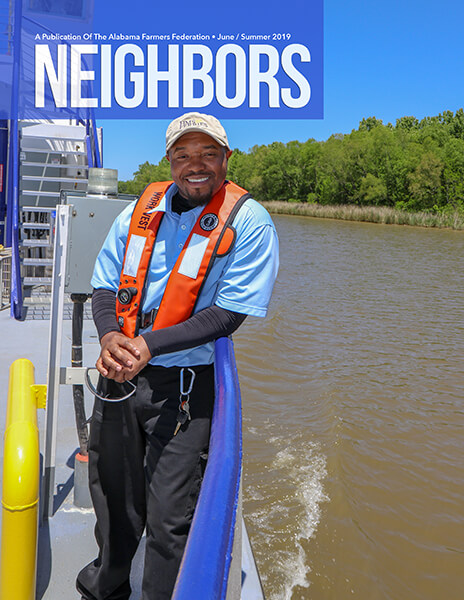Cockatoo, Caribou, Kangaroo: Hal Pate Heads The Montgomery Zoo Crew

It was May 1989. Hal Pate, 10 years out of vet school and two months into a gig as the Montgomery Zoo veterinarian, was de-worming a camel.
“This camel had been behaving so well, we thought we’d squirt the de-wormer in his mouth instead of mixing it in his feed,” remembered Pate, an Auburn University College of Veterinary Medicine graduate. “As soon as we threw the lasso around his neck to catch him, he freaked out and went berserk.”
In a twist of fate, Montgomery Advertiser newspaper reporters were on site. The next day, Pate, the camel and four handlers anchored the front page.
“We never did it that way again,” said the 63 year old.
The Montgomery Zoo was smaller then — 6 acres and 80 animals — and Pate spent two hours there weekly. Today, Pate and the zoo crew care for more than 450 animals from five continents, excluding Europe and Antarctica.
“As the zoo grew, I did too,” said Pate, the Alabama Veterinary Medical Association president whose term ends this month.
Pate spends two half-days each week at the 26-acre zoo, checking on issues reported by zookeepers, training animals and performing surgery. Pate Animal Clinic in Hayneville, his practice since 1979, fills his other days.
Pate’s 38 years around exotic animals benefit not just the zoo, but interns like Michelle Schisa, a recent veterinary school graduate.
“He can look at something and pretty much know right away or have a gut feeling exactly what it is, and he’s usually right,” said Schisa, a North Carolina State University vet school graduate. “It’s a skill that comes with experience, and it’s great to learn from him because he has that experience.”
Pate was raised on a farm with dogs, horses, chickens and some of Alabama’s first Charolais cattle. He still raises cattle and timber on the family property in Lowndes County.
Pate said experiences at his private clinic helped prepare him to work on exotic animals. For example, rhinoceroses have digestive tracks similar to horses; wolves are comparable to domesticated dogs; and many exotic, hooved animals are ruminants, just like cattle.
“Sometimes in the early days I thought, ‘What have I gotten myself into?’” Pate said. “You become more familiar with the animals as time goes on. You understand them, and they understand you.”
Pate’s patients run the gamut from large rodents like Patagonian cavies to ring-tailed lemurs, emerald tree boas, giant anteaters, peacocks, giraffes and Pygmy hippos.
His favorite? Pachyderms.
“I really appreciate what we can do with the elephants,” Pate said. “That an animal weighing 6,000 to 8,000 pounds can be trained to do certain behaviors so we can do physical exams on them, that’s impressive.”
Pate and his crew anesthetize and physically examine all zoo carnivores and primates — big cats, bears, wolves, squirrel monkeys, chimpanzees, etc. — around every two years.
“Really, the only difference with zoo animals is that we put them to sleep with a dart gun,” Pate said. “The other thing is, unlike a dog or cat, our animals will eat you if they wake up.”
Think of zookeepers as jacks-of-all-trades: horticulturists, farmers, manual laborers and workers keeping an eye out for signs of distress, similar to small animal owners noticing unusual actions from pets.
“Dogs are different because they’re bred to be companions. They’ll let you know when something doesn’t feel good,” said Rachel Lampkin, a zookeeper in the South America and reptile exhibits. “But these guys hide their injuries because in the wild, if you’re injured, you die.”
Enter Pate, who’s always ready for a challenge, whether it’s exploratory surgery on a tiger, a difficult birth, a rare giraffe knee condition or a root canal on a bear.
In addition to zoo duties and clinic hours, Pate is a past president of the Lowndes County Farmers Federation and serves on the board of directors.
“When you serve as a county president, that’s when you really learn about the organization,” said Pate, who lives in Lowndesboro with his wife, Mary. “I’ve really appreciated what the county organization and the Alabama Farmers Federation do for farmers.”
Pate and Mary have five children, including Brandon, who is in his second year studying veterinary medicine at Mississippi State University. He plans to practice at Pate Animal Clinic post graduation.
Pate and the zookeepers treat the animals like children. They bond over their entire lifespan, from birth. They sometimes name them thematically — “The Big Bang Theory,” “Harry Potter,” etc.
“I just sort of stumbled on the zoo,” Pate said. “It wasn’t in my plans when I went to school, but I’ll tell you: It’s probably been the thing I’ve enjoyed the most about practicing medicine.”
For more about the zoo, visit MontgomeryZoo.com.
